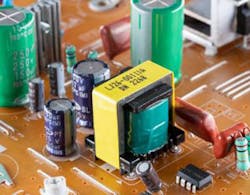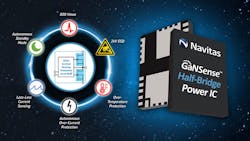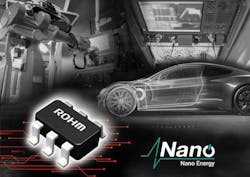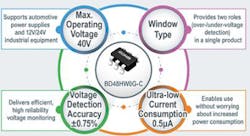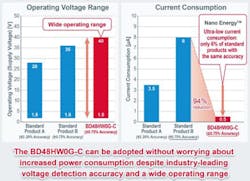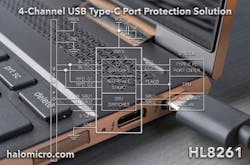This article is part of the This Week in PowerBites Library Series.
Dept. of Higher Education: Three "Powerful" Seminars to Keep Your Skills Sharp
As the pace of innovation in power technologies continues to accelerate, it can be tough to keep up with the latest advances and design practices. Lucky for you, we've got three online seminars that can help you keep your knowledge and skills up-to-date. The Motion Control seminar showcased here is an upcoming live webcast, but you can enjoy all three programs as replays at your convenience.
Live Event: Monday, Sept. 19, 2022:
Advancements in Motion Control Technology for Autonomous Mobile Robots
Use of autonomous mobile robots (AMRs) is increasing in a variety of industries to help automate processes, leading to improved productivity and efficiency. Ensuring they work as needed, a variety of motion-control solutions are necessary — from drive hardware and sensors to artificial intelligence and vision systems. This webinar features a panel discussion with industry experts who will provide their insights on:
- New technologies entering the market
- Advances in sensor designs
- The role of computers and data
- Market growth trends and more
Date: Monday, September 19, 2PM EDT / 1PM CDT / 11AM PDT
Hosted by: Power & Motion, via The Design Academy virtual learning program
Sponsored by: Maxon Precision Motors Inc.
Click here to register.
Can't join us for the live event? Register now, and we'll send you the on-demand viewing link shortly after the broadcast.
Available 24/7:
DC-DC Power Supply Design Issues & Delivery Solutions for Embedded Systems and Data Centers
A five-module course that takes you on a deep dive into dc-dc power supply design issues as well as power delivery and management solutions for embedded systems and data centers.
Hosted by: Power & Motion, via The Design Academy virtual learning program
For more information and registration, click here.
Available 24/7:
Powering the Future of Electric Vehicles
A six-module course that explores technologies and design practices for EVs across the gamut of pure electric to hybrid fluid power solutions.
Hosted by: Power & Motion, via The Design Academy virtual learning program
For more information and registration, click here.
News Flash: PowerBites just learned that The Design Academy also will be offering a live web seminar about Automotive Power Systems on Nov. 14, 2022 (details to follow soon). Stay tuned, and stay sharp!
Department of Advanced Integration
Below is a sampling of advances in chip-scale power components that are driving the electrified economy.
Integrated GaN Half-Bridge IC Supports MHz Switching, Shrinks BOM Count and Footprint
Navitas Semiconductor announced what it claims is the industry’s first GaNSense half-bridge power ICs. By integrating many of the components used in a classic half-bridge circuit, they can be operated at much higher switching speeds, while reducing the system cost and complexity. Applications include mobile fast chargers, consumer power adapters, data-center power supplies, solar inverters, energy storage, and electric-vehicle (EV) systems.
The half-bridge power ICs integrate two gallium-nitride (GaN) FETs with drive, control, sensing, autonomous protection, and level-shift isolation that can be used as power-stage building blocks to simplify designs and shorten development cycles. While some manufacturers currently offer half-bridge solutions that co-package power-transistor arrays with other active and passive components, Navitas says its GaNSense ICs integrate all of these elements on the chip itself.
This high level of integration reduces component count and footprint by over 60% (compared to existing discrete solutions) while nearly eliminating circuit parasitics and delays, enabling the devices to switch at megahertz speeds. The reduced parasitic effects also allow the output stage to switch much more cleanly, eliminating nearly all of the "glitching" and ringing commonly occurring in discrete solutions. Their ability to operate cleanly and efficiently at higher frequencies can improve the performance of many ac-dc power topologies while reducing system cost, size, weight, and complexity.
Thanks to these characteristics, Navitas' integrated half-bridge ICs are well-suited for LLC resonant, asymmetric half-bridge (AHB), active-clamp flyback (ACF), and totem-pole PFC circuits, as well as motor-drive applications. For example, the company claims that, in a typical 2-kW motor-drive application, the integrated GaN IC delivers 98.5% efficiency, versus 96% for a discrete GaN diver solution, reducing total losses by 50%
The initial family of GaNSense half-bridge ICs includes the NV6247, which is rated at 650 V, 160 mΩ (dual), and the NV6245C, rated at 275 mΩ (dual), both housed in a standard, low-profile, low-inductance, 6- × 8-mm PQFN package. The NV6247 is immediately available in production with 16-week lead times, while the NV6245C is sampling to select customers and will be broadly available in production to all customers in Q4 2022. A wide range of package styles and power levels will become available in the coming quarters.
Additional details on the devices and their applications can be found in Navitas' dedicated Application Note AN018.
Automotive MCU Optimized for EV Platform System Integration
A new series of automotive-grade MCUs unveiled by STMicroelectronics is specifically designed to support the requirements of next-generation EVs. In addition to a complement of integrated I/O elements tailored to support advanced electrified drivetrains, they include the networking and security features required to implement domain-oriented, over-the-air updatable systems that are the foundation of software-defined EVs.
Notably, ST’s Stellar P automotive MCUs integrate the new CAN XL in-car communication standard. It will enable new vehicle platforms to efficiently manage the ever-growing levels of data traffic in advanced vehicle drivetrains, as well as the advanced safety, navigation, assisted/automated driving navigation/control platforms.
Manufactured using 28-nm FD-SOI technology, all Stellar P6 MCUs contain up to six Arm Cortex-R52 processor cores, some operating in lockstep and some in split-lock mode to provide failsafe redundancy. This enables high-performance, real-time determinism, and upgradability for next-generation automotive drivetrains, electrification solutions, and domain-oriented systems.
Stellar P6 manages hardware virtualization (sandboxing) using the Cortex-R52 features and firewalls to resource access. They can be configured with up to 20 MB of phase-change (non-volatile) memory (PCM), qualified for high-temperature operation, radiation hardening, and extended data retention.
Each series in the Stellar MCU family has been designed to support a specific aspect of the transition toward software-defined vehicles:
- The Stellar E series assures fast real-time control and system miniaturization in power-conversion applications, maximizing the benefits of SiC and GaN power technology in EVs’ on-board charging, dc-dc converters, and traction inverters, among other applications.
- The Stellar G series MCUs act as a secure data hub and real-time, safe aggregator of functions within the body domain primarily for zonal architectures. They include features that support software-defined vehicles, including updates, low-power modes, and data routing over a broad set of in-car communication protocols.
- The new Stellar P series of automotive MCUs offers qualifiable devices that combine advanced actuation capabilities with powerful function integration. Stellar P devices target the new drivetrain trends for electric vehicles and domain-oriented architectures, for the best real-time performance and energy management.
Samples of Stellar P6 are available now for model-year 2024 vehicles. Contact your local ST Sales office for pricing options and sample requests.
Department of Power Protection
Since powerful applications require powerful protection, we've rounded up some of the latest developments from the cutting edge of the power universe to use in your upcoming designs.
High-Accuracy 40-V Window-Type Voltage Detector Features Ultra-Low Consumption
ROHM Semiconductor's high-accuracy, ultra-low current consumption voltage detector (reset IC) BD48HW0G-C is optimized for a wide range of automotive and industrial applications that require voltage monitoring of electronic circuits for increased safety. These include automotive electronic control units (ECUs) and factory-automation equipment. It was developed in response to the automotive and industrial equipment sectors' increased focus on safer product designs that incorporate fail-safe and functional-safety features.
The BD48HW0G-C is fabricated using a high-voltage BiCDMOS process, enabling it to support designs with operating voltages up to 40 V. Its adjustable detection voltage can be set between 1.8 to 40 V with an accuracy of ±0.75%. It also takes advantage of ROHM’s proprietary ultra-low current consumption technology (Nano Energy), which reduces current consumption to just 500 nA (0.5 μA, only 6% of equivalent standard products).
Thanks to its high accuracy and low power consumption, it’s well-suited for use in battery-powered automotive systems which must remain operational when the engine is stopped. The BD48HW0G-C's robust electrical and thermal ratings also allow it to be used in a wide range of other power-supply circuits in automotive and industrial applications requiring functional safety.
Operating temperature range is 40 to 125°C in a 2.9- × 2.8- × 1.25-mm SSOP6. Samples are available now, with mass production starting in October 2022.
ROHM has a lineup of over 1,000 other voltage detectors. For more information, click here.
Fast-Starting Load Switch Targets Automotive, Industrial Safety Systems
STMicroelectronics’ IPS1025HF is a fast-starting high-side power switch for use in safety systems that require minimal power-on delay time. The IPS1025HF responds to turn-on and turn-off signals in less than 60 µs, even considering the VCC power-on and off, enabling protective systems to ensure a specified safety-integrity level (SIL).
Featuring a very wide input-voltage range (8.65 to 60 V) and able to tolerate up to 65 V on the input pin, the compact devices withstand harsh industrial operating conditions. Applications include power control for programmable logic controllers (PLCs), vending machines, factory-automation I/O peripherals, and computer-numerical-control (CNC) machines.
Like similar single-channel and dual devices in ST’s intelligent power switch family, the IPS1025HF has two programmable current-limit settings that allow the user to program a higher current limitation value at power switch activation. This enhances flexibility for driving loads such as bulb lamps, motors, and capacitive loads that demand high initial peak current.
The output stage is a N-channel power MOSFET with a typical on-resistance (RDS(on)) of 12.5 mW at ambient temperature, ensuring high energy efficiency and low thermal dissipation. The MOSFET is internally limited at 2.5-A minimum output current and has single-pulse avalanche energy up to 14 joules for higher reliability while handling inductive loads. There’s also an integrated active clamp for fast demagnetization.
The switch includes protection against undervoltage, overvoltage, overload, short circuit, ground disconnection, and Vcc disconnection. On-chip diagnostics include individual signaling of output overload and junction overtemperature. There’s an extra thermal sensor to detect excessive case temperature. The device is designed to meet IEC 61000-4-2 ESD, IEC 61000-4-4, and IEC 61000-4-5 specifications for ESD, fast-transient, and surge immunity.
For fast evaluation, the X-NUCLEO-OUT15A1 expansion board contains an IPS1025HF with associated circuitry ready to connect to STM32 Nucleo development boards. A demonstration firmware pack, STSW-OUT15F4, and industrial-automation system design GUI, STSW-IFAPGUI, also are available and enable users to realize an entire industrial-automation environment on the desktop.
The IPS1025HF is in production now, available in both PowerSSO-24 and QFN48L packages, priced from $3.51 for orders of 1.000 units. For more information, click here.
4-Channel USB Type-C Port ESD Protection with No Speed Penalty
Halo Microelectronics has released the HL8261, a 4-channel USB Type-C port protector for all computing, docking, and adapter essentials. It offers an ultra-fast overvoltage-protection (OVP) response time of 30 ns (versus other competitor's 70 ns) while supporting full-speed transfers across sideband-use (SBU) channels in applications such as personal computers, Chromebooks, docking stations, port dongles, and adapters.
Protecting USB Type-C ports against electrostatic discharge (ESD) can be challenging because their SBU channels can carry high-speed data, and some mechanisms used to shield the pins can add capacitance, therefore limiting the data transfer bandwidth. In addition, Type-C connectors' higher pin counts, smaller pin pitches, and higher operating voltages increases the likelihood of damage from unwanted conditions, such as overvoltage, voltage surge, and shorts.
When the HL8261 detects an overvoltage condition on the CC and SBU pins, it shuts down all four conducting paths to protect the system downstream from damage. With four input pins at 24-V dc absolute maximum rating, the HL8261 provides robust protection against 20-V short-to-VBUS overvoltage conditions.
The HL8261 is designed to be RoHS- and green-compliant and comes in a 16-bump WLCSP package. Find more information at https://halomicro.com.
High-Power Fuse Series Optimized for High-Voltage EV/HEV Apps, Accessory Circuit Protection
Bourns Inc. introduced a new series of fuses to its POWrFuse High-Power Fuse family. Specifically designed to meet ISO 8820-8 standards, the POWrFuse Model PF-K Series provides protection for high-voltage accessory circuits in electric vehicles (EVs) and hybrid electric vehicles (HEVs). These circuits are found in multiple automotive applications, including electrical energy storage (ESS), battery disconnect units (BDUs), and battery-management systems (BMS).
These high-voltage EV fuses support operation up to 500 V dc. They feature a 20-kA at 500-V dc interrupting rating and an extended temperature range of −55 to +125 °C. Individual models within the PF-K Series have current ratings from 15 to 50 A and are available in bolt and PCB mounting options. All POWrFuse EV fuses have been tested to Bourns’ internal automotive quality standards for environmental reliability, transient current cycling, and device electrical and fusing characteristics.
The Bourns POWrFuse Model PF-K Series models, available now, are RoHS-compliant and halogen-free.
California Fights Drought and Climate Change with Solar-Shaded Canals
By using miles-long solar canopies to protect part of California's extensive canal system against evaporative losses, Project Nexus will explore a novel way to cope with long-term drought conditions while helping halt the climate change that caused them.
The $20 million pilot project, currently underway in California's Turlock Irrigation District (TID), will construct shade canopies composed of solar panels over various sections of the district's canal system. It will serve as a proof of concept for larger projects while providing important information about designing and deploying solar-over-canal systems, as well as the co-benefits of combined water conservation and grid-scale solar systems.
The pilot project will break ground in mid-October at two locations:
- A 500-foot span of a canal in Hickman, east of Modesto
- A mile-long canal span in the nearby city of Ceres
Scheduled to break ground in early 2023 and be complete in 2024, Project Nexus will be used to demonstrate the feasibility of using narrow and wide-span canal coverage of solar panels for combined water conservation and grid-scale renewable power generation. This includes how effectively they can be used to reduce evaporative losses in canals and the challenges of integrating them with the state's distribution and storage network.
If the pilot is successful, it could lead to covering most of California’s 4,000 miles of canals in solar panels, which could save 63 billion gallons of water annually, roughly the amount needed to irrigate 50,000 acres of farmland or meet the residential water needs of more than 2 million people. Once complete, the system would have a peak capacity of 13 GW, enough to power 9.75 million of California's estimated 13.1 million households (based on a study conducted July 2021) during daylight hours.
This is about one-sixth of the state’s total installed generating capacity, or half the projected new solar capacity needed to meet the state’s 2030 decarbonization goals. The added renewable capacity also will help the state support its commitment to ban the sale of gasoline-powered vehicles by 2035 and its goal of requiring medium- and heavy-duty trucks to be zero emission by 2045 "where feasible."
See our feature story "Solar-Shaded Canals May Help California Fight Drought and Climate Change" and "Energy and water co-benefits from covering canals with solar panels," published in Nature, Sustainability, for additional details.
Read more articles in the This Week in PowerBites Library Series.


